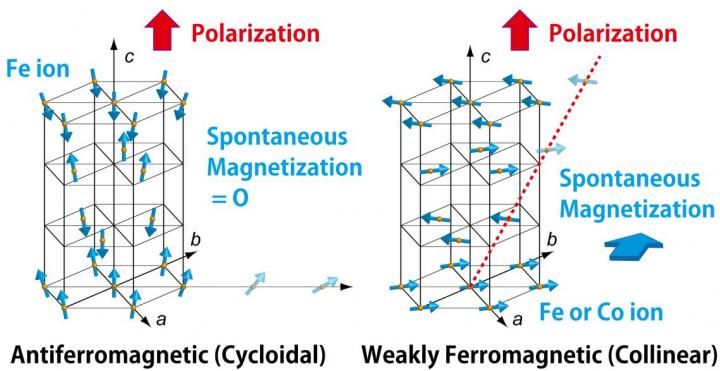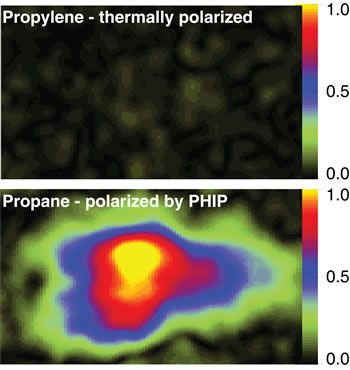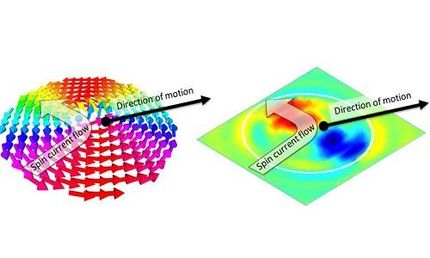New material with ferroelectricity and ferromagnetism may lead to better computer memory
Traditional computer memory, known as DRAM, uses electric fields to store information. In DRAM, the presence or absence of an electric charge is indicated either by number 1 or number 0. Unfortunately, this type of information storage is transient and information is lost when the computer is turned off. Newer types of memory, MRAM and FRAM, use long-lasting ferromagnetism and ferroelectricity to store information. However, no technology thus far combines the two.

Portions of the BiFeO3 lattice of cycloidal and collinear phases with only Fe ions are shown at left and right, respectively. The arrows indicate the Fe3+ moment direction. The ground state of BiFeO3 had a cycloidal spin structure, which is destabilized by substitution of Co for Fe and at higher temperatures. The spin magnetic moments compensate with each other in the left panel, but canting between neighboring spins leads to the appearance of weak ferromagnetism in the left panel.
Tokyo Institute of Technology
To address this challenge, a group of scientists led by Prof. Masaki Azuma from the Laboratory for Materials and Structures at Tokyo Institute of Technology, along with associate Prof. Hajime Hojo at Kyushu University previously at Tokyo Tech, Prof. Ko Mibu at Nagoya Institute of Technology and five other researchers demonstrated the multiferroic nature of a thin film of BiFe1-xCoxO3 (BFCO). Multiferroic materials exhibit both ferromagnetism and ferroelectricity. These are expected to be used as multiple-state memory devices. Furthermore, if the two orders are strongly coupled and the magnetization can be reversed by applying an external electric field, the material should work as a form of low power consumption magnetic memory.
Previous scientists had speculated that ferroelectric BFO thin film, a close relative of BFCO, might be ferromagnetic as well, but they were thwarted by the presence of magnetic impurity. Prof. M. Azuma's team successfully synthesized pure, thin films of BFCO by using pulsed laser deposition to perform epitaxial growth on a SrTiO3 (STO) substrate. They then conducted a series of tests to show that BFCO is both ferroelectric and ferromagnetic at room temperature. They manipulated the direction of ferroelectric polarization by applying an electric field, and showed that the low-temperature cychloidal spin structure, essentially the same as that of BiFeO3, changes to a collinear one with ferromagnetism at room temperature.
In the future, the scientists hope to realize electrical control of ferromagnetism, which could be applied in low power consumption, non-volatile memory devices.
Original publication
Most read news
Other news from the department science

Get the chemical industry in your inbox
By submitting this form you agree that LUMITOS AG will send you the newsletter(s) selected above by email. Your data will not be passed on to third parties. Your data will be stored and processed in accordance with our data protection regulations. LUMITOS may contact you by email for the purpose of advertising or market and opinion surveys. You can revoke your consent at any time without giving reasons to LUMITOS AG, Ernst-Augustin-Str. 2, 12489 Berlin, Germany or by e-mail at revoke@lumitos.com with effect for the future. In addition, each email contains a link to unsubscribe from the corresponding newsletter.
Most read news
More news from our other portals
Last viewed contents
Last_universal_ancestor
New ISO Technical Report for safer manufacturing and handling of nanomaterials
Röntgen

BASF and Security Matters collaborate to accelerate progress towards a circular economy for plastics - Create new value for plastics to tackle global challenge

Berkeley Scientists Bring MRI/NMR to Microreactors
Category:EC_5.1


























































